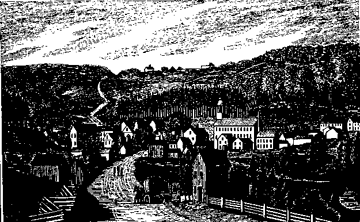

The town of Torrington, which lay in Windsor's portion of eastern Litchfield county, was settled in 1737 and incorporated in 1740. It was named from Great Torrington in the English Devonshire. A high hill country is cut by various branches of the Naugatuck River. Torrington contains the Paugnut State Forest, named for the last Indian chief in this region.
The city of Tornngton was chartered in 1923, and has a population of 26,040. The area originally was a swamp covered with dense pine forest, and avoided by the early settlers. In 1813, Oliver Wolcott, Jr., of Litchfield established a large woolen mill on the Naugatuck, and the name of Orleans Village was changed to Wolcottville. The brass industry was established by Israel Coe in 1834, with machinery, and workmen brought from England and transported by team from the coast. He was the first in the U. S. to make brass kettles by machine. The railroad up the valley was opened in 1849. Among present industries, some of them of long standing, are brass goods, machine tools, needles, hardware, sporting goods, and cloth for uniforms.
In the center of the city is the triangular Coe Memorial Park, given in memory of Lyman W. Coe, who in 1863 purchased and developed the brass industry started by his father, which became the nucleus of the great American Brass Co. Across from the Park is the marble Library, a gift to the city from Elisha Turner. Southwest of the center, by Litchfield St., on a commanding site, stands Charhotte Hungerford hospital, one of the finest in the State, given in memory of his mother by Uri T. Hungerford, a native of Torrington, who became a wealthy brass merchant in New York. Charlotte Hungerford typifies the sturdy Litchfield County stock which has trained so many famous sons. On our way to the Hospital, to the left before crossing the R.R., is the Brooker Memorial, in memory of another mother. The group of buildings with endowment for visiting nurse service were the gift of Charles F. Brooker, organizer of the American Brass Co. The large boulder, brought down from Torringford, bears the inscription: "Her children shall rise up and call her blessed."
West of the city limits, on the south side of Highland Ave., is the old Ives House, built in 1761. The Jacob Strong House (Fowler Homestead) lies 2 miles west on the same road, to our left. This section was the site of the first settlement, and a mound on the left side of Allen St., on the brow of the hill, marks the site of the Fort erected as a protection against Mohawk raids.
Northwest of the city, R. 4 to Goshen and R. 49 to Norfolk make scenic drives. As we climb the hill from West Torrington on R. 4, the site of an old Indian Fort lies to our left, about 3/4 mile from the junction. Turning north from R. 4 on Pothier Rd., we reach in 1 mile on the left the birthplace of John Brown (1800-1859) the famous abolitionist; only the cellar remains. John Brown's parents moved from here to Ohio when he was 5 years old. On R. 49, we pass the new Still Water Pond.
To the east, R. 4 climbs a steep hill and goes through attractive country. About 2 1/2 miles from the center we reach Torringford Street. Turning north, Cary Aviation Field lies to our right, and on our left we pass a stone marking the site of the first church in Torrington in 1746. North of the Torringford Congregational Church, the present parsonage is on the site of the house occupied by Rev. Samuel J. Mills, a man of unusual stature and Yankee wit, who served for 64 years. His son, Samuel J. Mills, Jr. (1783-1818) was a member of the famous Haystack Band at Williams College, and a leading spirit in starting the foreign mission movement in America and the American Bible Society; he himself served as a missionary in the Southwest.
U. S. 8 goes north to Winsted. At Burrville, we turn west to the attractive Burr Pond in Paugnut State Forest, the road climbing through a fine ravine. There are facilities for bathing, and a path has been laid out along the pond. We pass on our left the factory building where Gail Borden made the first condensed milk, in 1857. On Starks hill Rd., 1 1/2 miles from Burrville, there is a good view to the south.